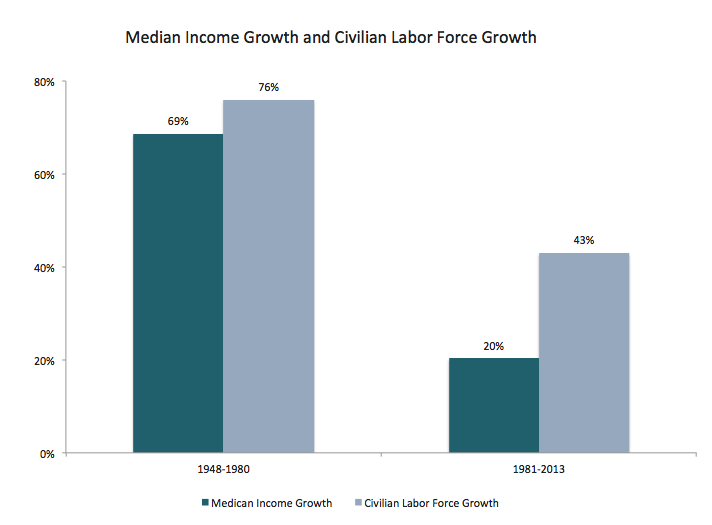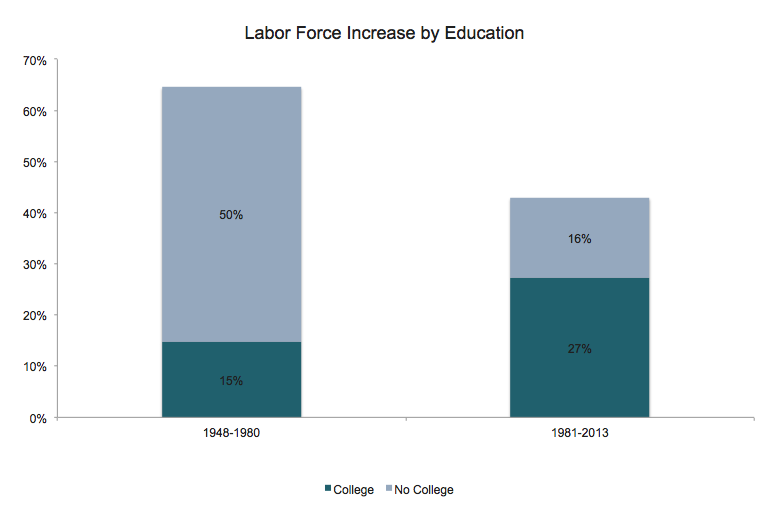MORE WORKERS MEAN MORE INCOME
Opponents of legal immigration rely heavily on the view that recent increases in immigration since 1980 are to blame for lower wages. “What has happened to the labor market since 1980?” Senator Jeff Sessions (R-AL) said in Senate floor speech last year, continuing:
From 1980 through 2013, the immigrant population tripled from 14 million to more than 41 million. The sustained large-scale flow of legal immigration, overwhelmingly lower-wage and lower-skilled, has placed substantial downward pressure on wages… Only an adjustment in policy will change this trajectory, just as policy was changed early in the 20th century to allow labor markets to tighten.[i]
But his basic assumption—that labor markets are being flooded with new workers—is wrong. Sen. Sessions’ sole focus on immigrants misses the bigger picture of the labor market, which is composed of both immigrants and native-born workers. After factoring in the number of native-born workers entering the labor force each year, labor markets have tightened considerably since 1980. Since 1980, more immigrants began joining the labor force at the same time fewer Americans were being born. The lower birthrates resulted in lower rate of increase overall from new workers, foreign and domestic.
Since 1980, America has had less competition from new workers entering the labor force than before 1980. In the 33 years from 1948 to 1980, the labor force grew by 76 percent,[ii] and median income for wage and salary workers shot up by almost 70 percent.[iii] In the following 33 years from 1981 to 2013, the labor force grew just 43 percent—almost half the earlier amount—yet median income rose only 20 percent. Since new job-seeking has declined since 1980, new job seekers—foreign and domestic—cannot explain the lower income growth. Policymakers should look for other explanations.
The labor force has not been rapidly expanding in the last few years either. From 2006 to 2015, the labor force grew by just 4 percent, compared to 23 percent in the ten years from 1966 to 1975.[iv] In fact, this decade has seen the weakest growth in the labor force since the government began collecting statistics on it in the early 20th century.[v] The reality is that America is experiencing an abnormal dearth of new workers, not a historic influx.
Advocates for restricting immigration might argue that the lower growth rate could be due to Americans being displaced from the labor force by foreign-born competitors. But the data at the most basic level simply do not support this conclusion. In fact, from 1981 to 2013, America had a significantly higher labor force participation rate (66 percent) than during the 1948 to 1980 period (60 percent).[vi] Just because more immigrants started working did not mean that fewer Americans did.
Senator Sessions sticks the blame for lower wage growth on “lower-skilled” workers in particular, implying perhaps that the American workers of the 1950s, 60s, and 70s were not lower-skilled. But this view is also mistaken. From 1948 to 1980,[vii] workers without a college degree accounted for 71 percent of the increase in the labor force. From 1981 to 2013, the numbers were reversed: 63 percent of the increase came from college graduates.
New college graduates by themselves grew the labor force by 21 percent from 1948 to 1980 and by 27 percent from 1981 to 2013. Labor force growth from college graduates has hardly shifted, meaning that the lower labor force growth was almost entirely due to fewer workers without a college degree. In fact, 98 percent of the decline in labor force growth since 1980 came from a lower rate of entry of lesser-skilled workers into the workforce, exactly the “low wage” workers that Sen. Sessions blames for the wage stagnation. If competition from new “low wage” workers is down, blame for lower wage growth must lie elsewhere.
Nor is an influx of high school dropouts hurting wages. Despite being a disproportionate share of foreign-born workers compared to native-born workers (12 percent compared to 7.5 percent in 2013),[viii] the number of high school dropouts has plunged in absolute terms. Their ranks also fell between 1947 and 1980, but 1981 to 2013 actually witnessed twice the annual rate of decline in the number of high school dropouts in the United States.[ix] In other words, not only is competition from “low wage” workers not increasing, it is falling faster than ever.
CONCLUSION
Opponents of immigration want to focus on competition from immigrant workers, but even as more foreign workers have been admitted, the number of native-born workers entering the labor force each year has declined. When looking at the full picture, overall competition for jobs from new workers has fell since 1980. If Americans face less competition today at all skills levels than they did previously when wages were rising, then increased competition for jobs cannot explain lower wage growth.
Immigration restrictionists have already achieved their goal of tighter labor markets, but with negative results. Congress should look back to the earlier era of robust labor force growth as a model and reform the immigration system to allow workers a legal avenue for entry to the United States.
Read the full study here.
CITATIONS
[i] Later published at: Jeff Sessions, “Who’s Looking Out for the American Workers?” National Review, December 12, 2014. http://www.nationalreview.com/article/394614/whos-looking-out-american-worker-jeff-sessions
[ii] U.S. Bureau of Labor Statistics, “Civilian Labor Force.” Federal Reserve Bank of St. Louis. Accessed May 4, 2015. https://research.stlouisfed.org/fred2/series/CLF16OV/
[iii] Census.gov, “Historical Income Table, Table P-53. Wage or Salary Workers by Median Wage or Salary Income and Sex,” accessed February 5, 2015. https://www.census.gov/hhes/www/income/data/historical/people/
[iv] U.S. Bureau of Labor Statistics, “Civilian Labor Force.” Federal Reserve Bank of St. Louis. Accessed May 4, 2015. https://research.stlouisfed.org/fred2/series/CLF16OV/
[v] U.S. Department of Commerce. “Historical Statistics of the United States: Colonial Times to 1970: Part 1.” 1975. Accessed May 4, 2015. https://ia700407.us.archive.org/4/items/HistoricalStatisticsOfTheUnitedStatesColonialTimesTo1970/us_historical_statistics_colonial_times_to_1970.pdf
[vi] U.S. Bureau of Labor Statistics, “Civilian Labor Force Participation Rate.” Federal Reserve Bank of St. Louis. Accessed May 4, 2015. https://research.stlouisfed.org/fred2/series/CIVPART
[vii] Bureau of the Census. “Statistical Abstracts of the United States 1960: Section 4.” 1960. Accessed May 13, 2015. https://www.census.gov/prod/www/statistical_abstract.html
1967-1990: Current Population Survey cited in: Daniel Hecker, “Reconciling conflicting data on jobs for college graduates.” Bureau of Labor Statistics, July 1992. http://www.bls.gov/mlr/1992/07/art1full.pdf
1992-2013: Bureau of Labor Statistics cited in: Federal Reserve Bank of St. Louis. “Civilian Labor Force Level – Bachelor’s degree and higher, 25 years and over.” Accessed May 13, 2015.
https://research.stlouisfed.org/fred2/graph/?id=LNS11027662,#
[viii] Bureau of Labor Statistics. “Table 3. Employment status of the foreign-born and native-born populations 25 years and over by educational attainment, race, and Hispanic or Latino ethnicity, 2012-2013 annual averages.” May 22, 2014. Accessed May 4, 2015. http://www.bls.gov/news.release/forbrn.t03.htm
[ix] Census Bureau. “CPS Historical Time Series Table: Table A-2. Percent of People 25 Years and Over Who Have Completed High School or College, by Race, Hispanic Origin and Sex: Selected Years 1940 to 2014.” Accessed May 4, 2015. http://www.census.gov/hhes/socdemo/education/data/cps/historical/

